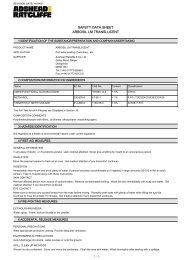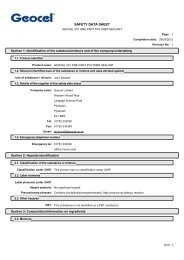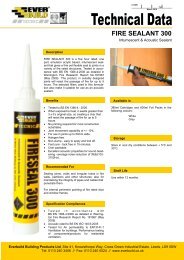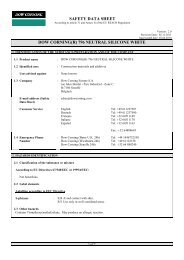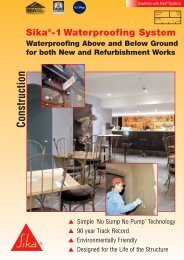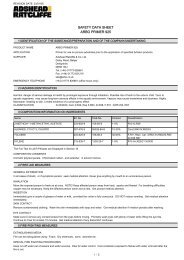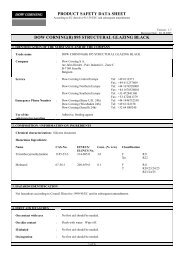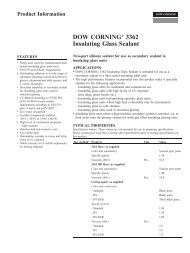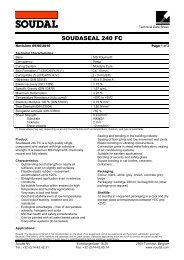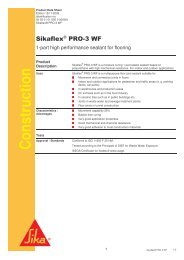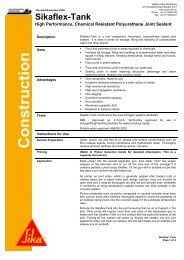SAFETY DATA SHEET DOW CORNING(R) 3362 HV ... - Geocel
SAFETY DATA SHEET DOW CORNING(R) 3362 HV ... - Geocel
SAFETY DATA SHEET DOW CORNING(R) 3362 HV ... - Geocel
Create successful ePaper yourself
Turn your PDF publications into a flip-book with our unique Google optimized e-Paper software.
<strong>SAFETY</strong> <strong>DATA</strong> <strong>SHEET</strong>According to article 31 and Annex II of the EU REACH RegulationVersion: 2.0Revision Date: 31.05.2011Superseded date: 01.02.2010<strong>DOW</strong> <strong>CORNING</strong>(R) <strong>3362</strong> <strong>HV</strong> INSULATING GLASS CATALYST BLACK1. IDENTIFICATION OF THE SUBSTANCE/PREPARATION AND OF THE COMPANY1.1 Product name : <strong>DOW</strong> <strong>CORNING</strong>(R) <strong>3362</strong> <strong>HV</strong> INSULATING GLASS CATALYST BLACK1.2 Identified uses : Vulcanising agentsUses advised against : None known.1.3 Company : Dow Corning Europe S.A.rue Jules Bordet - Parc Industriel - Zone CB-7180 SeneffeBelgiumE-mail address (SafetyData Sheet): sdseu@dowcorning.comCustomer Service : English Tel: +49 611237507Deutsch Tel: +49 611237500Français Tel: +32 64511149Italiano Tel: +32 64511170Español Tel: +32 64511163Fax: +32 648886831.4 Emergency PhoneNumber: Dow Corning (Barry U.K. 24h)Dow Corning (Wiesbaden 24h)Dow Corning (Seneffe 24h)Tel: +44 1446732350Tel: +49 61122158Tel: +32 64 8882402. HAZARDS IDENTIFICATION2.1 Classification of the substance or mixtureAccording to EU Directives 67/548/EEC or 1999/45/EC:R10 Flammable.R36 Irritating to eyes.R43 May cause sensitization by skin contact.R48/22 Harmful: danger of serious damage to health by prolonged exposure if swallowed.R52/53 Harmful to aquatic organisms, may cause long-term adverse effects in the aquatic environment.2.2 Label elementsLabelling according to EEC DirectiveContains : Trimethoxy(methyl)silaneSymbols : Xn Harmful.: N-(3-(Trimethoxysilyl)propyl)ethylenediamine: 1,6-Bis(trimethoxysilyl)hexane1 of 12
<strong>SAFETY</strong> <strong>DATA</strong> <strong>SHEET</strong>According to article 31 and Annex II of the EU REACH RegulationVersion: 2.0Revision Date: 31.05.2011Superseded date: 01.02.2010<strong>DOW</strong> <strong>CORNING</strong>(R) <strong>3362</strong> <strong>HV</strong> INSULATING GLASS CATALYST BLACKR-phrases : R10 Flammable.R36 Irritating to eyes.R43 May cause sensitization by skin contact.R48/22 Harmful: danger of serious damage to health by prolonged exposure if swallowed.R52/53 Harmful to aquatic organisms, may cause long-term adverse effects in the aquaticenvironment.S-phrases : S23(V) Do not breathe vapour.S24/25 Avoid contact with skin and eyes.S26 In case of contact with eyes, rinse immediately with plenty of water and seek medicaladvice.S37 Wear suitable gloves.S51 Use only in well-ventilated areas.S61 Avoid release to the environment. Refer to special instructions/Safety data sheets.2.3 Other hazardsVapours may form explosive mixtures with air.2 of 12
<strong>SAFETY</strong> <strong>DATA</strong> <strong>SHEET</strong>According to article 31 and Annex II of the EU REACH RegulationVersion: 2.0Revision Date: 31.05.2011Superseded date: 01.02.2010<strong>DOW</strong> <strong>CORNING</strong>(R) <strong>3362</strong> <strong>HV</strong> INSULATING GLASS CATALYST BLACK3. COMPOSITION / INFORMATION ON INGREDIENTSChemical characterization: Mixture of Methyl Siloxane and Organic CompoundAccording to EU Directives 67/548/EEC or 1999/45/EC:Name CAS-No. EINECS/ELINCSNo.REACHRegistrationNumberConc.(% w/w)ClassificationCarbon black 1333-86-4 215-609-9 - 15.0 Substance with a Community workplaceexposure limitTrimethoxy(methyl)sila 1185-55-3 214-685-0 01-21195174 12.0 R43ne36-40FR11Amino functionalalkoxysilanes474530-85-3 Exempt ornot available- 12.0 Xi R36N-(3-(Trimethoxysilyl)propyl)ethylenediamine1760-24-3 217-164-6 - 4.9 Xn R20XiR41R43N R51/531,6-Bis(trimethoxysilyl)hexane87135-01-1 Exempt ornot available- 4.0 T R48/25XiR37Methylated silica 68611-44-9 271-893-4 - 1.8 Substance with a Community workplaceexposure limitMethanol 67-56-1 200-659-6 - 0.85 F R11TR23/24/25R39/23/24/25Dimethylbis[(1-oxoneodecyl)oxy]stannane68928-76-7 273-028-6 - 0.1 Xn R22T R48/25Xn, Toxic for reproduction - category 3.R63R53According to Regulation (EC) No. 1272/2008:Name CAS-No. EINECS/ELINCSNo.REACHRegistrationNumberConc.(% w/w)ClassificationCarbon black 1333-86-4 215-609-9 - 15.0 Substance with a Community workplace exposurelimitTrimethoxy(methyl)silane1185-55-3 214-685-0 01-2119517436-4012.0 Flammable liquid: Category 2 - H225Skin sensitization: Category 1 - H317Amino functionalalkoxysilanes474530-85-3 Exempt ornot available- 12.0Serious eye damage/eye irritation: Category 2 -H3193 of 12
<strong>SAFETY</strong> <strong>DATA</strong> <strong>SHEET</strong>According to article 31 and Annex II of the EU REACH RegulationVersion: 2.0Revision Date: 31.05.2011Superseded date: 01.02.2010<strong>DOW</strong> <strong>CORNING</strong>(R) <strong>3362</strong> <strong>HV</strong> INSULATING GLASS CATALYST BLACKN-(3-(Trimethoxysilyl)propyl)ethylenediamine1760-24-3 217-164-6 - 4.9Acute toxicity (Inhalation - dust and mist): Category4 - H332Serious eye damage/eye irritation: Category 1 -H318Skin sensitization: Category 1 - H317Chronic aquatic hazard: Category 2 - H4111,6-Bis(trimethoxysilyl)hexane87135-01-1 Exempt ornot available- 4.0Specific target organ toxicity - single exposure(Inhalation - vapour): Category 3 (respiratory tractirritation) - H335Specific target organ toxicity - repeated exposure(Oral): Category 1 (bladder) - H372Methylated silica 68611-44-9 271-893-4 - 1.8 Substance with a Community workplace exposurelimitMethanol 67-56-1 200-659-6 - 0.85 Flammable liquid: Category 2 - H225Acute toxicity (Oral): Category 3 - H301Acute toxicity (Dermal): Category 3 - H311Acute toxicity (Inhalation - vapour): Category 3 -H331Specific target organ toxicity - single exposure(Dermal): Category 1 (eye - retina) - H370Specific target organ toxicity - single exposure(Inhalation - vapour): Category 1 (eye - retina) -H370Specific target organ toxicity - single exposure(Oral): Category 1 (eye - retina) - H370Dimethylbis[(1-oxoneodecyl)oxy]stannane68928-76-7 273-028-6 - 0.1Acute toxicity (Oral): Category 4 - H302Reproductive toxicity (Oral): Category 2 - H361dSpecific target organ toxicity - repeated exposure(Oral): Category 1 (central nervous system, thymusgland, kidney) - H372Chronic aquatic hazard: Category 4 - H413For the full text of the R-phrases mentioned in this Section, see Section 16.For the full text of the H-Statements mentioned in this Section, see Section 16.CLP classifications are based on all current available data including from known international organizations. These classifications are subject to revision asmore information becomes available.4. FIRST AID MEASURES4.1 Description of First Aid Measures:On contact with eyes : Immediately flush with water. Obtain medical attention immediately.On skin contact : Flush with water. Wipe off. Obtain medical attention.If inhaled : Remove to fresh air.4 of 12
<strong>SAFETY</strong> <strong>DATA</strong> <strong>SHEET</strong>According to article 31 and Annex II of the EU REACH RegulationVersion: 2.0Revision Date: 31.05.2011Superseded date: 01.02.2010<strong>DOW</strong> <strong>CORNING</strong>(R) <strong>3362</strong> <strong>HV</strong> INSULATING GLASS CATALYST BLACKOn ingestion : Obtain medical attention immediately.4.2 Most importantsymptoms/effects, acuteand delayed: Irritating to eyes.May cause sensitization by skin contact.Harmful: danger of serious damage to health by prolonged exposure if swallowed.5. FIRE-FIGHTING MEASURES5.1 Suitable extinguishingmediaUnsuitable extinguishingmedia5.2 Hazards during firefightingHazardous CombustionProducts5.3 Special protectiveequipment/procedures: On large fires use dry chemical, foam or water spray (fog). On small fires use carbondioxide (CO2), dry chemical or water spray. Water can be used to cool fire exposedcontainers.: None known.: Electrostatic charges may be generated during transfer of product from its container.Ensure that all equipment is electrically earthed.Vapours may form explosive mixtures with air.: Thermal breakdown of this product during fire or very high heat conditions may evolvethe following decomposition products: Silica. Carbon oxides and traces of incompletelyburned carbon compounds. Formaldehyde. Nitrogen products.: A self-contained respirator and protective clothing should be worn. Determine the need toevacuate or isolate the area according to your local emergency plan. Use water spray tokeep fire exposed containers cool.6. ACCIDENTAL RELEASE MEASURES6.1 Personal precautions,protective equipment andemergency procedures6.2 Environmentalprecautions6.3 Methods and materials forcontainment and cleaningup: A self-contained respirator and protective clothing should be worn. Determine the need toevacuate or isolate the area according to your local emergency plan. Eliminate all possiblesources of ignition.: Do not empty into drains. Prevent from spreading or entering into drains, ditches or riversby using sand, earth or other appropriate barriers. Inform local authorities if this cannot beprevented.: Determine the need to evacuate or isolate the area according to your local emergency plan.Eliminate all possible sources of ignition. Very large spills should be contained bybunding, etc... procedures. Mop, wipe or soak up with absorbent material and place in acontainer with a lid. The spilled product produces an extremely slippery surface.5 of 12
<strong>SAFETY</strong> <strong>DATA</strong> <strong>SHEET</strong>According to article 31 and Annex II of the EU REACH RegulationVersion: 2.0Revision Date: 31.05.2011Superseded date: 01.02.2010<strong>DOW</strong> <strong>CORNING</strong>(R) <strong>3362</strong> <strong>HV</strong> INSULATING GLASS CATALYST BLACK7. HANDLING AND STORAGE7.1 Advice on safe handling : General ventilation is required. Local ventilation is recommended. Do not breathevapour. Do not breathe spray or mist. Avoid skin and eye contact. Do not ingest. Do notempty into drains.7.2 Advice on storage : Store in a flameproof, well ventilated area. Electrostatic charges may be generated duringtransfer of product from its container. Ensure that all equipment is electrically earthed.Keep container tightly closed.Vapours may form explosive mixtures with air.Storage temperature: minimum 5 °C, maximum 25 °C7.3 Specific uses : Refer to technical data sheet available on request.8. EXPOSURE CONTROLS / PERSONAL PROTECTION8.1 Control parametersName CAS-No. Exposure LimitsCarbon black 1333-86-4 3.5 mg/m3 TWA7 mg/m3 STELTrimethoxy(methyl)silane 1185-55-3 50 ppm (8h TWA) - Dow Corning recommendation.Amino functional alkoxysilanes 474530-85-31,000 ppm TWA as ethanol200 ppm TWA as methanol250 ppm STEL as methanol1,920 mg/m3 TWA as ethanol266 mg/m3 TWA as methanol333 mg/m3 STEL as methanolN-(3-(Trimethoxysilyl)propyl)ethylenediamine1760-24-3 250 ppm STEL as methanol200 ppm TWA as methanol333 mg/m3 STEL as methanol266 mg/m3 TWA as methanol1,6-Bis(trimethoxysilyl)hexane 87135-01-1 200 ppm TWA as methanol250 ppm STEL as methanol266 mg/m3 TWA as methanol333 mg/m3 STEL as methanolMethylated silica 68611-44-9 4 mg/m3 TWA Respirable dust10 mg/m3 TWA Inhalable dustMethanol 67-56-1 200 ppm TWA250 ppm STEL266 mg/m3 TWA333 mg/m3 STELDimethylbis[(1-oxoneodecyl)ox 68928-76-7 0.1 mg/m3 TWA as Sn6 of 12
<strong>SAFETY</strong> <strong>DATA</strong> <strong>SHEET</strong>According to article 31 and Annex II of the EU REACH RegulationVersion: 2.0Revision Date: 31.05.2011Superseded date: 01.02.2010<strong>DOW</strong> <strong>CORNING</strong>(R) <strong>3362</strong> <strong>HV</strong> INSULATING GLASS CATALYST BLACKChronic toxicity:On skin contact : Can irritate on prolonged or repeated contact. Repeated contact can cause sensitisationand allergic dermatitis. Prolonged or repeated dermal contact may cause systemicadverse effect.If inhaled : Prolonged or repeated inhalation may cause systemic adverse effects.On ingestion : Repeated swallowing may cause damage to specific organ(s) - see section 3. Repeatedswallowing may cause systemic adverse effects.Toxicokinetics, metabolismand distributionOther Health HazardInformation: Dangerous amounts can be absorbed through the skin.: This product contains (a) powder(s) hazardous by inhalation. This is not relevant to thecurrent physical form of the product, which is not in a respirable form.12Based on product test data.Based on test data from similar products.12. ECOLOGICAL INFORMATION12.1 Ecotoxicity effectsHarmful to aquatic organisms and may cause long-term adverse effects in the aquatic environment.12.2 Persistence and degradabilityThis product hydrolyses in water or moist air, releasing methanol and organosilicons. Siloxanes are removed fromwater by sedimentation or binding to sewage sludge. In soil, siloxanes are degraded.12.3 BioaccumulationNo bioaccumulation potential.12.4 Release to waters / Mobility in soilFate and effects in waste water treatment plants:Removed > 90% by binding onto sewage sludge. May cause adverse effects on bacteria. The siloxanes in thisproduct do not contribute to the BOD.9 of 12
<strong>SAFETY</strong> <strong>DATA</strong> <strong>SHEET</strong>According to article 31 and Annex II of the EU REACH RegulationVersion: 2.0Revision Date: 31.05.2011Superseded date: 01.02.2010<strong>DOW</strong> <strong>CORNING</strong>(R) <strong>3362</strong> <strong>HV</strong> INSULATING GLASS CATALYST BLACK13. DISPOSAL CONSIDERATIONSProduct and packagingdisposal: This material must be disposed of as hazardous waste. Dispose of in accordance withlocal regulations. According to the European Waste Catalogue, Waste Codes are notproduct specific, but application specific. Waste codes should be assigned by the user,preferably in discussion with the waste disposal authorities.14. TRANSPORT INFORMATIONRoad / Rail (ADR/RID)UN No. : UN 1993Proper Shipping Name : FLAMMABLE LIQUID, N.O.S.(Methoxysilane / Methanol)Class : 3Packing group : IIILabels : 3Sea transport (IMDG)UN No. : UN 1993Proper Shipping Name : FLAMMABLE LIQUID, N.O.S.(Methoxysilane / Methanol)Class : 3Packing group : IIIEmergency Schedule(EmS): F-ES-ELabels : flammable liquidAir transport (IATA)UN No. : UN 1993Proper Shipping Name : Flammable liquid, n.o.s.(Methoxysilane / Methanol)Class : 3Packing group : IIILabels : Flammable Liquid10 of 12
<strong>SAFETY</strong> <strong>DATA</strong> <strong>SHEET</strong>According to article 31 and Annex II of the EU REACH RegulationVersion: 2.0Revision Date: 31.05.2011Superseded date: 01.02.2010<strong>DOW</strong> <strong>CORNING</strong>(R) <strong>3362</strong> <strong>HV</strong> INSULATING GLASS CATALYST BLACK15. REGULATORY INFORMATION15.1 Safety, health and environmental regulations/legislation specific for the substance or mixtureStatusIECSC : All ingredients listed or exempt.DSL : Consult your local Dow Corning office.TSCA : For R&D purposes only. One or more of the components of this product may not be listed onthe TSCA inventory of chemical substances. Product should be used solely for scientificexperimentation, research or analysis under the supervision of technically qualifiedindividuals.KECL : One or more ingredients are not listed or exempt or identified.EINECS : Not determined.11 of 12
<strong>SAFETY</strong> <strong>DATA</strong> <strong>SHEET</strong>According to article 31 and Annex II of the EU REACH RegulationVersion: 2.0Revision Date: 31.05.2011Superseded date: 01.02.2010<strong>DOW</strong> <strong>CORNING</strong>(R) <strong>3362</strong> <strong>HV</strong> INSULATING GLASS CATALYST BLACK16. OTHER INFORMATIONThis product safety data sheet was prepared in compliance with article 31 and Annex II of the EU REACH Regulation as well asits relevant amendements, on the approximation of laws, regulations and administrative provisions relative to the classification,packaging and labelling of dangerous substances and preparations.It is the responsibility of persons in receipt of this Product Safety Data Sheet to ensure that the information contained herein isproperly read and understood by all people who may use, handle, dispose or in any way come in contact with the product. If therecipient subsequently produces a formulation containing the Dow Corning product, it is the recipient's sole responsibility toensure the transfer of all relevant information from the Dow Corning Product Safety Data Sheet to their own Product SafetyData Sheet in compliance with article 31 and Annex II of the EU REACH Regulation.All information and instructions provided in this Safety Data Sheet (SDS) are based on the current state of scientific andtechnical knowledge at the date indicated on the present SDS. Dow Corning shall not be held responsible for any defect in theproduct covered by this SDS , should the existence of such defect not be detectable considering the current state of scientificand technical knowledge.As stated above, this Safety Data Sheet has been prepared in compliance with applicable European law. If you purchase thismaterial outside Europe, where compliance laws may differ, you should receive from your local Dow Corning supplier a SDSapplicable to the country in which the product is sold and intended to be used. Please note that the appearance and content of theSDS may vary - even for the same product - between different countries, reflecting the different compliance requirements.Should you have any question, please refer to your local Dow Corning supplier.Source of information: Internal data and publically available informationR11 Highly flammable., R20 Harmful by inhalation., R22 Harmful if swallowed., R23/24/25 Toxic by inhalation, in contactwith skin and if swallowed., R36 Irritating to eyes., R37 Irritating to respiratory system., R39/23/24/25 Toxic: danger of veryserious irreversible effects through inhalation, in contact with skin and if swallowed., R41 Risk of serious damage to eyes., R43May cause sensitization by skin contact., R48/25 Toxic: danger of serious damage to health by prolonged exposure ifswallowed., R51/53 Toxic to aquatic organisms, may cause long-term adverse effects in the aquatic environment., R53 Maycause long-term adverse effects in the aquatic environment., R63 Possible risk of harm to the unborn child.H225 Highly flammable liquid and vapour., H301 Toxic if swallowed., H302 Harmful if swallowed., H311 Toxic in contactwith skin., H317 May cause an allergic skin reaction., H318 Causes serious eye damage., H319 Causes serious eye irritation.,H331 Toxic if inhaled., H332 Harmful if inhaled., H335 May cause respiratory irritation., H361d Suspected of damaging theunborn child., H411 Toxic to aquatic life with long lasting effects., H413 May cause long lasting harmful effects to aquatic life.12 of 12



